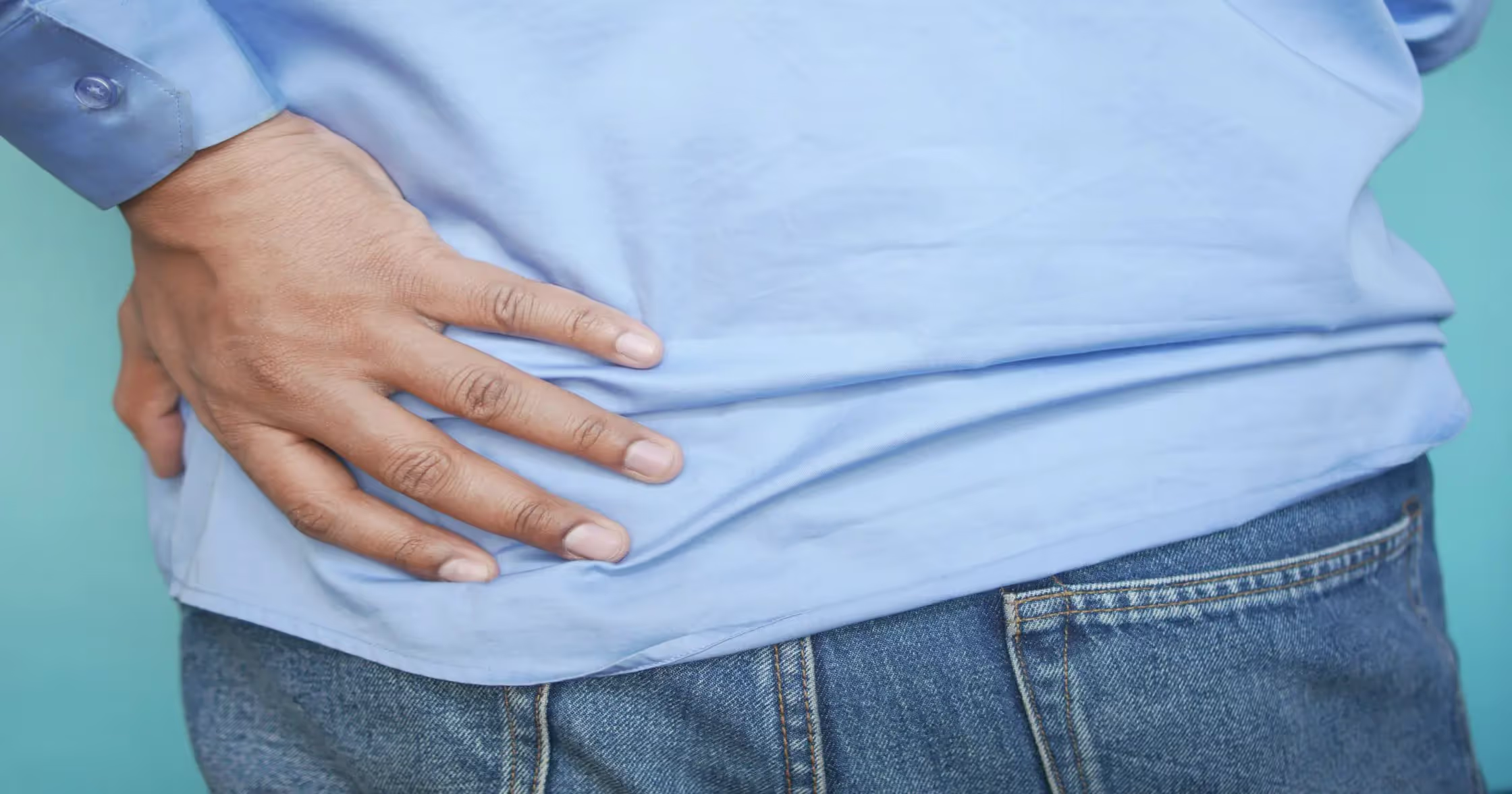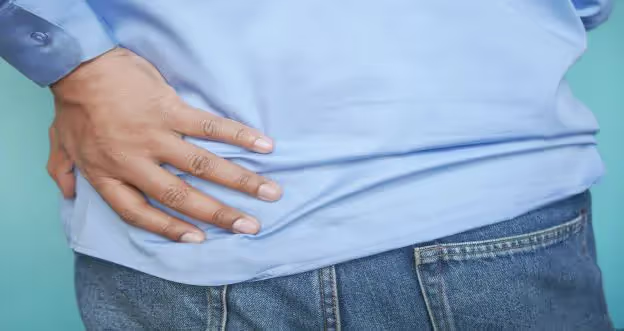
Back Pain vs Hip Pain: A Doctor's Guide to Telling the Difference
If you're experiencing pain in your lower back or hip area, you might be wondering exactly where the pain is coming from. As a physical therapist, when a patient tells me they've back pain or hip pain, I automatically go into detective mode. Why? Because the pain could be coming from the hip, the lower back, or sometimes both at the same time.
This diagnostic challenge is more common than you might think. In fact, research shows that nearly half of all patients presenting with low back pain also have concurrent hip issues¹. The human body is wonderfully complex, and these areas are so interconnected that sometimes even MRI scans don't always show the root cause of back pain.
In this guide, we'll explore the key differences between hip and back pain, share simple tests you can do at home to help identify the source of your pain, and discuss when it's time to seek professional help.
*Disclaimer: This blog is not a substitute for a thorough examination from your medical provider. Before trying any of the tests in this blog or performing any exercise, make sure you are safe and appropriate to exercise by consulting with your medical provider.
Understanding Pain Patterns: Back Pain vs. Hip Pain
Understanding pain patterns is crucial because they can tell us a lot about the underlying cause². The hip joint and lower back share a complex network of nerves the come together in the lower back. Which is why pain in one area can sometimes be caused by problems in the other. This phenomenon, known as referred pain, is why proper diagnosis is so important.
Hip Pain Characteristics
Hip pain typically manifests in the front of the hip or groin area, often radiating to the front of the thigh but rarely extending past the knee. You might notice increased discomfort when lying on your side or getting up from a seated position or when getting in and out of the car!
Many patients report that their pain improves slightly after taking a few steps, as the joint warms up with movement. Motion is lotion for then joint.
Back Pain Characteristics
Back pain usually centers in the lower back region or buttocks and may radiate down the back of the leg, sometimes extending past the knee which often similar to sciatica. True back pain often does well wit specific stretches for both the back and hips. Prolonged sitting or standing typically aggravates the condition, and you might experience muscle spasms or tightness in the back muscles.
There are many types of back pain but most generally it's achy, stiff, and doesn't referral into the front of the leg, which hip pain does.
The Connection Between Hip and Back Pain
Understanding the differences between hip and back pan is important a reviewing the characteristics of each will be helpful for treatment. That said, there hasn't been a single patient of mine the we didn't work on both the hip and lower back when treating hip or lower back pain. We treat both because they are so highly connected in your body. You can't move your back without some hip movement.
Three Key Tests for Self-Assessment
Before attempting these tests, ensure you're near a stable surface and stop immediately if you experience significant pain. These tests aren't diagnostic tools but can provide valuable insights about your condition.
- Modified FABER test: Sit comfortably and cross one ankle over the opposite knee. Gently press down on the raised knee. Lean forward slightly while maintaining good posture. Note where you feel tension or pain.
- The Walking Assessment: Take a short walk and notice initial vs. ongoing pain levels; changes with longer steps; any limping patterns; pain location and intensity changes.
- Single Leg Balance: Stand near a wall for safety. Lift one foot off the ground. Hold for 30 seconds if possible. Compare sides.
Seated Test Results
If during the seated test you experience:
- Stretching sensation in the glute area that provides relief: This often indicates piriformis muscle involvement
- Pain in the front of your hip: This typically suggests hip joint involvement or tight hip flexors. Hip joint issues often involve deeper pain in the groin area.
- Back pain or no change in symptoms: When the test position causes back discomfort or doesn't affect your symptoms, the source is more likely spinal.
Walking Assessment Results
Your walking test results might reveal:
- Pain that improves after initial steps: Typically indicates hip joint involvement, particularly conditions like arthritis or degeneration
- Pain that worsens in the lower back with continued walking: More commonly associated with spine-related issues or stenosis
Balance Test Interpretation
During the single-leg balance test:
- Difficulty maintaining balance: Often indicates hip muscle weakness or instability
Making Sense of Combined Results
Remember that these tests work best when considering their results together. For example:
- If you have positive findings for hip involvement on all three tests, you're likely dealing primarily with a hip issue
- If your symptoms are inconsistent across tests but generally worsen with spine movement, you might be dealing with a back condition
- Mixed results could indicate involvement of both areas, which is quite common
The Exception Zone: Sometimes pain doesn't follow these simple rules. The area where your side pockets would be (the outer hip) can be particularly tricky because problems in either the hip or back can cause pain here. This is what we call the "grey zone," and it's where we need to look at other symptoms and perform specific tests to determine the true source³.
Common Causes and Their Symptoms
Back-Related Conditions
Most back pain stems from muscle strains, disc issues, or spinal stenosis. Muscle strains typically respond well to rest and gentle movement, while disc problems often worsen with sitting. Spinal stenosis characteristically causes pain during prolonged walking or standing but improves with sitting. But, 90% of lower back pain is hard to 100% accurately diagnose.
Hip-Related Conditions
Hip conditions like osteoarthritis typically cause groin pain and morning stiffness that improves with movement. And, if you are age 50 or greater. Hip impingement often affects younger, active individuals and creates sharp pain with deep hip flexion.
Red Flags: When to Seek Immediate Care
The following symptoms require immediate medical attention:
Back Pain Red Flags:
- Loss of bladder or bowel control
- Progressive leg weakness
- Numbness in the groin area
- Frequent unexplained fevers
- Unexplained weight loss
Hip Pain Red Flags:
- Inability to bear weight with trauma
- Signs of infection such as fever and chills
- Significant swelling
- Obvious changes in structure
Treatment and Prevention for Hip and Back Pain
Conservative Care Options Often First
Best evidence says we need to consider treatments that don't involve risk first. This includes gentle exercises, activity modification, and other modalities such as ice and heat. When we do this combined with time, most get better.
Professional Treatment
A physical therapist or healthcare provider can offer:
- Specific exercise programs for YOUR body
- Manual therapy techniques
- Education
- Give you confidence in your body
Next Steps
If you're experiencing hip or back pain that persists beyond a few weeks or significantly impacts your daily activities, it's time to seek professional help. Look for providers who take time to assess both areas thoroughly and create individualized treatment plans focused on long-term solutions.
Remember: While hip and back pain can be complex, understanding the source of your pain is the first step toward effective treatment. Don't hesitate to seek professional help if you're uncertain about your symptoms or if they're affecting your quality of life.
If you're in the Jacksonville, Florida area and struggling with hip or back pain, I provide specialized in-home physical therapy services. This personalized approach allows me to assess your movement patterns in your natural environment and create a targeted treatment plan that fits your lifestyle.
References
If you're experiencing pain in your lower back or hip area, you might be wondering exactly where the pain is coming from. As a physical therapist, when a patient tells me they've back pain or hip pain, I automatically go into detective mode. Why? Because the pain could be coming from the hip, the lower back, or sometimes both at the same time.
This diagnostic challenge is more common than you might think. In fact, research shows that nearly half of all patients presenting with low back pain also have concurrent hip issues¹. The human body is wonderfully complex, and these areas are so interconnected that sometimes even MRI scans don't always show the root cause of back pain.
In this guide, we'll explore the key differences between hip and back pain, share simple tests you can do at home to help identify the source of your pain, and discuss when it's time to seek professional help.
*Disclaimer: This blog is not a substitute for a thorough examination from your medical provider. Before trying any of the tests in this blog or performing any exercise, make sure you are safe and appropriate to exercise by consulting with your medical provider.
Understanding Pain Patterns: Back Pain vs. Hip Pain
Understanding pain patterns is crucial because they can tell us a lot about the underlying cause². The hip joint and lower back share a complex network of nerves the come together in the lower back. Which is why pain in one area can sometimes be caused by problems in the other. This phenomenon, known as referred pain, is why proper diagnosis is so important.
Hip Pain Characteristics
Hip pain typically manifests in the front of the hip or groin area, often radiating to the front of the thigh but rarely extending past the knee. You might notice increased discomfort when lying on your side or getting up from a seated position or when getting in and out of the car!
Many patients report that their pain improves slightly after taking a few steps, as the joint warms up with movement. Motion is lotion for then joint.
Back Pain Characteristics
Back pain usually centers in the lower back region or buttocks and may radiate down the back of the leg, sometimes extending past the knee which often similar to sciatica. True back pain often does well wit specific stretches for both the back and hips. Prolonged sitting or standing typically aggravates the condition, and you might experience muscle spasms or tightness in the back muscles.
There are many types of back pain but most generally it's achy, stiff, and doesn't referral into the front of the leg, which hip pain does.
The Connection Between Hip and Back Pain
Understanding the differences between hip and back pan is important a reviewing the characteristics of each will be helpful for treatment. That said, there hasn't been a single patient of mine the we didn't work on both the hip and lower back when treating hip or lower back pain. We treat both because they are so highly connected in your body. You can't move your back without some hip movement.
Three Key Tests for Self-Assessment
Before attempting these tests, ensure you're near a stable surface and stop immediately if you experience significant pain. These tests aren't diagnostic tools but can provide valuable insights about your condition.
- Modified FABER test: Sit comfortably and cross one ankle over the opposite knee. Gently press down on the raised knee. Lean forward slightly while maintaining good posture. Note where you feel tension or pain.
- The Walking Assessment: Take a short walk and notice initial vs. ongoing pain levels; changes with longer steps; any limping patterns; pain location and intensity changes.
- Single Leg Balance: Stand near a wall for safety. Lift one foot off the ground. Hold for 30 seconds if possible. Compare sides.
Seated Test Results
If during the seated test you experience:
- Stretching sensation in the glute area that provides relief: This often indicates piriformis muscle involvement
- Pain in the front of your hip: This typically suggests hip joint involvement or tight hip flexors. Hip joint issues often involve deeper pain in the groin area.
- Back pain or no change in symptoms: When the test position causes back discomfort or doesn't affect your symptoms, the source is more likely spinal.
Walking Assessment Results
Your walking test results might reveal:
- Pain that improves after initial steps: Typically indicates hip joint involvement, particularly conditions like arthritis or degeneration
- Pain that worsens in the lower back with continued walking: More commonly associated with spine-related issues or stenosis
Balance Test Interpretation
During the single-leg balance test:
- Difficulty maintaining balance: Often indicates hip muscle weakness or instability
Making Sense of Combined Results
Remember that these tests work best when considering their results together. For example:
- If you have positive findings for hip involvement on all three tests, you're likely dealing primarily with a hip issue
- If your symptoms are inconsistent across tests but generally worsen with spine movement, you might be dealing with a back condition
- Mixed results could indicate involvement of both areas, which is quite common
The Exception Zone: Sometimes pain doesn't follow these simple rules. The area where your side pockets would be (the outer hip) can be particularly tricky because problems in either the hip or back can cause pain here. This is what we call the "grey zone," and it's where we need to look at other symptoms and perform specific tests to determine the true source³.
Common Causes and Their Symptoms
Back-Related Conditions
Most back pain stems from muscle strains, disc issues, or spinal stenosis. Muscle strains typically respond well to rest and gentle movement, while disc problems often worsen with sitting. Spinal stenosis characteristically causes pain during prolonged walking or standing but improves with sitting. But, 90% of lower back pain is hard to 100% accurately diagnose.
Hip-Related Conditions
Hip conditions like osteoarthritis typically cause groin pain and morning stiffness that improves with movement. And, if you are age 50 or greater. Hip impingement often affects younger, active individuals and creates sharp pain with deep hip flexion.
Red Flags: When to Seek Immediate Care
The following symptoms require immediate medical attention:
Back Pain Red Flags:
- Loss of bladder or bowel control
- Progressive leg weakness
- Numbness in the groin area
- Frequent unexplained fevers
- Unexplained weight loss
Hip Pain Red Flags:
- Inability to bear weight with trauma
- Signs of infection such as fever and chills
- Significant swelling
- Obvious changes in structure
Treatment and Prevention for Hip and Back Pain
Conservative Care Options Often First
Best evidence says we need to consider treatments that don't involve risk first. This includes gentle exercises, activity modification, and other modalities such as ice and heat. When we do this combined with time, most get better.
Professional Treatment
A physical therapist or healthcare provider can offer:
- Specific exercise programs for YOUR body
- Manual therapy techniques
- Education
- Give you confidence in your body
Next Steps
If you're experiencing hip or back pain that persists beyond a few weeks or significantly impacts your daily activities, it's time to seek professional help. Look for providers who take time to assess both areas thoroughly and create individualized treatment plans focused on long-term solutions.
Remember: While hip and back pain can be complex, understanding the source of your pain is the first step toward effective treatment. Don't hesitate to seek professional help if you're uncertain about your symptoms or if they're affecting your quality of life.
If you're in the Jacksonville, Florida area and struggling with hip or back pain, I provide specialized in-home physical therapy services. This personalized approach allows me to assess your movement patterns in your natural environment and create a targeted treatment plan that fits your lifestyle.
References




%20Blog%20thumbnails%204.avif)
